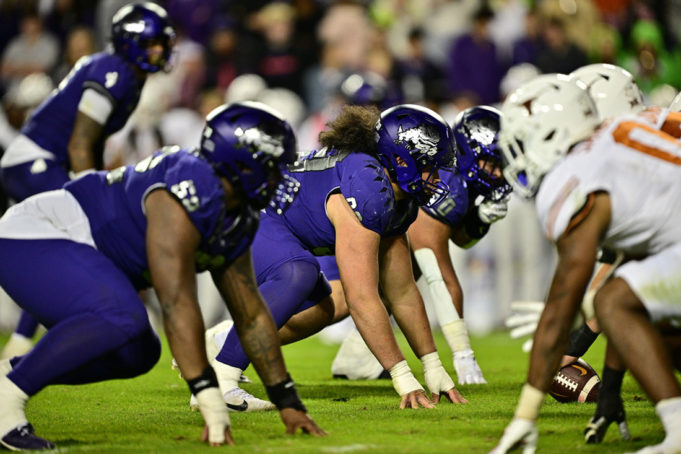If you’re a regular reader, you’ll know that last week I pointed out how miserably the Frogs’ current offense and defenses complement each other. Saturday while hosting Texas was the timely personification of my point. I also planted my flag that both Kendal Briles and Joe Gillespie should be dismissed at the conclusion of the season, but after a near-victory against Texas, I’m convinced OC Briles needs to be the first or only coach to go.
TCU took an early field-goal lead in this contest after the Frog defense stopped the Horns on their first drive and turned them over via downs on the second. A well-executed UT screen netted a touchdown, and Briles’ offense responded with a long second field goal by Griffin Kell. What happened next was demonstrative of TCU’s luck this season: Purple safety Nook Bradford intercepted a long pass from Quinn Ewers and dipped, dived, and dodged his way for a long return only to have the ball punched out and recovered by Texas, which flipped what would have been outstanding field position for Sonny Dykes’ fledgling team into an eventual Bevo field goal.
TCU’s offense produced nothing else during the half, and the Horns created scoreboard distance with another kick before scoring two touchdowns in fewer than five minutes thanks partially to an interception.
With TCU trailing 26-6 at the half and the defense struggling, the game seemed over, but that’s not really what happened on the field. TCU’s defense was rejuvenated after two weeks of lackluster performances. Frog defenders gang tackled and kept their gaps well but did struggle in the open field against UT’s receivers. The two-touchdown explosion at the end of the half was largely the fault of the Frog offense.
The Longhorns’ final touchdown came thanks to a 43-yard field, and when the squads left for the locker rooms, UT was winning the time of possession battle 2:1. It’s too much to ask a defense to adequately slow an opponent who is on the field twice as much as their own.
Despite the late collapse, Gillespie’s defenders responded by allowing zero points in the third quarter and only a field goal the rest of the game. Briles’ side did their part, to a degree, by scoring two touchdowns on their final two drives, and an already overextended defense stymied the Longhorns to put the purple offense in a position to win. The only thing fans need know regarding this offense — and subsequent play calling — is that the Frogs acquired a third-quarter scoring opportunity at 3rd and goal from the Longhorn 2-yard line. Two incomplete passes later, and the Frogs had turned the ball over to continue trailing by 20 points. Their continued ineptitude in the red zone is the only explanation needed for this 6-loss season in which four of them have been by one possession, averaging four points per contest against those teams. TCU’s offense squandered what was the best performance by the Frog defense this season save for the BYU game.
I dislike levying blame on officials — it’s generally a loser’s calling card — but since TCU are likely to finish as such, the zebras in this game were horrible and provided Longhorn receiver Xavier Worthy with gubernatorial-level protection on his way to 137 yards on 10 receptions. Frog receivers gathered no such consideration, which is understandable considering the Austinites are the Big 12’s only chance — and it’s an unlikely one — of backing into the College Football Playoff.
As the Longhorns depart for the SEC, they escape from their greatest conference nemesis in TCU, who are 8-4 against UT since joining the Big 12. Only the Sooners have beaten the Longhorns more often during the same span, and the two will be bonded together in SEC glory for the foreseeable future.
Continuing with the theme of formerly Big 12/now SEC teams, news of the Aggies from College Station firing Head Coach Jimbo Fisher flooded the interwebs on Sunday. The decision was made during the university’s board of regents meeting last Thursday. Fisher spent the weekend destroying Mississippi State 51-10 to gain bowl eligibility for someone else. Fisher’s hiring was consistent with Texas A&M’s identity of lighting money on fire and yell-leading their relevance to anyone who’ll listen. Fisher, who had been the eighth-highest paid head coach in the NCAA, has had two 9-win seasons since taking the wheel of the Aggie tractor in 2018 but missed a bowl last year and wasn’t going to surpass eight regular-season wins this year.
A&M firing their head coach isn’t groundbreaking news, but paying him $77.6 million to not coach is. Just two years ago, Jimbo received an ill-advised 10-year $95-million-guaranteed contract extension amid rumors he might leave for LSU. Recruiting rankings are among the issues with Fisher’s perceived success. Depending on which service you patronize, the Ags have trapped a Top-10 recruiting class every year since Fisher arrived, but their off-season success hasn’t translated to a superior SEC placing. Fisher had generally the same level of success as his predecessor, Kevin Sumlin. The Aggies haven’t won more than nine games since their first year in the SEC, when Johnny Manziel won the Heisman, and College Station has captured only one conference championship in the last 30 years, which was 25 years ago for the team’s first and only Big 12 title. But now, the Maroon and White can remind everyone they are the champions of the buyout. Previously, Sumlin had been a mere 10th on the list of the most expensive buyouts in college coaching history, and now Fisher is the frontrunner, destroying Auburn’s former coach Gus Malzahn by $56.2 million — that’s 362% more expensive. Impressive.
College Station is a fiduciary-expectation cautionary tale and a reminder that money doesn’t necessarily buy you happiness or success and that booster expectations can invite the opposite. The Aggies earned the seventh most revenue of any college football program last season, and I’m not sure they’ll give the next head honcho a blank national championship trophy — or check, as it were — like they did Fisher, but you can be sure they’ll have a slew of candidates ready to suffer four years in Nowheresville, Texas, to receive a separation package that any CEO or hedge-fund manager would drool over.
In other wildness, Jim Harbaugh is currently serving a conference-imposed sanction for the rest of the regular season because of an elaborate signal-stealing operation that has allegedly been years in the making. A former scouting analyst has even been accused of Jason Bourne-ing himself onto opposing sidelines in the weeks before teams were to face the Wolverines. Harbaugh served the first game of his second suspension of the season on Saturday as the Maize and Blue bested Penn State in their own house. My take won’t be a popular one, but who cares? The illusion of sportsmanship or fair play in the amateur NFL evaporated in the 1980s, and that’s just my perception because it’s the decade of my birth. It was likely well before then.
As a recovered football coach, I’m saying it’s on coaches and their staff to devise a system that can’t be deciphered or send plays in the ol’ fashioned way: by screaming into the helmet hole of a player coming to the sideline. If someone can steal and decipher your plays before they’re called, then you aren’t trying hard enough. You can’t convince me that teams who have multiple graduate assistants assemble a sphinx statue around their signal callers can’t construct a method to camouflage or change their signals week to week. Dykes even said they were aware of the malfeasance before the Frogs’ semifinal matchup last year and used the knowledge against the Michiganders and successfully so. Harbaugh’s suspension is being challenged in court, and the University of Michigan has even sent information to their conference alleging Ohio State, Purdue, and Rutgers conspired together against the Wolverines to steal their offensive signals. This whole scandal is a nothing burger, which is ironic, since burgers have been particularly problematic for the Michigan coach as it pertains to suspensions so far this year.
TCU has two games left and is not mathematically eliminated from appearing in the Manscaped Smoothest-Balls Bowl but play perhaps their last likely winnable game against their oldest rival on Saturday. The 3-7 Baylor Bears are having an even more miserable season than our Frogs, but both teams are 2-5 in conference. The Bears began the season with an embarrassing loss to Texas State before dropping a one-touchdown game to a ranked Utah team. Since then, the Frogs and Bears have been similarly embarrassed by Kansas State and Iowa State, and the Bears have fallen in two heartbreakers, to UCF and Houston, each game by a single point.
The collective marketing geniuses are trying to rebrand the now most played rivalry between Lone Star State teams as the Bluebonnet Battle. The new moniker is — for lack of more descriptive language — stupid. Bluebonnets are the Texas state wildflower, but both universities are private. Both institutions are religion-based, but apparently the commonly used Revivalry wasn’t good enough. Each school had its start in Waco, but the city isn’t mentioned. Especially this year, the contest — which will be shown only on ESPN+ if that’s any indication of how bad these teams are playing — should be known as the Battle of I-35. Both schools are definitely a work in progress, both will never truly be a finished product before needing to add something to keep up, and both are accessible from that road, and being there will cause one to question life and if it was worth making the trip at all.












